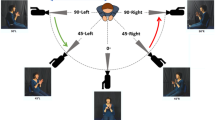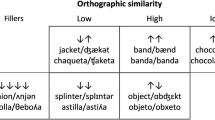Abstract
A large body of literature has characterized unimodal monolingual and bilingual lexicons and how neighborhood density affects lexical access; however there have been relatively fewer studies that generalize these findings to bimodal (M2) second language (L2) learners of sign languages. The goal of the current study was to investigate parallel language activation in M2L2 learners of sign language and to characterize the influence of spoken language and sign language neighborhood density on the activation of ASL signs. A priming paradigm was used in which the neighbors of the sign target were activated with a spoken English word and compared the activation of the targets in sparse and dense neighborhoods. Neighborhood density effects in auditory primed lexical decision task were then compared to previous reports of native deaf signers who were only processing sign language. Results indicated reversed neighborhood density effects in M2L2 learners relative to those in deaf signers such that there were inhibitory effects of handshape density and facilitatory effects of location density. Additionally, increased inhibition for signs in dense handshape neighborhoods was greater for high proficiency L2 learners. These findings support recent models of the hearing bimodal bilingual lexicon, which posit lateral links between spoken language and sign language lexical representations.




Similar content being viewed by others
Notes
Capitalized Deaf often refers to those individuals who were born deaf and consider themselves part of Deaf culture, including using American Sign Language, whereas the lowercase deaf often refers just to audiological status among those who are late-deafened or do not identify with the Deaf community.
Per linguistic convention, ASL signs are represented in small capital letters.
paper and cheese are phonological neighbors in sign language because they share the same location and handshape, but differ by movement (see Brentari 1998).
References
Bachman, L. F., & Palmer, A. S. (1989). The construct validation of self-ratings of communicative language ability. Language Testing, 6(1), 14–29.
Berent, I., Dupuis, A., & Brentari, D. (2013). Amodal aspects of linguistic design. PloS One, 8(4), e60617.
Bochner, J. H., Christie, K., Hauser, P. C., & Searls, J. M. (2011). When is a difference really different? Learners’ discrimination of linguistic contrasts in American Sign Language. Language Learning, 61(4), 1302–1327.
Brentari, D. (1998). A prosodic model of sign language phonology. Cambridge, MA: MIT Press.
Carreiras, M., Gutiérrez-Sigut, E., Baquero, S., & Corina, D. (2008). Lexical processing in Spanish sign language (LSE). Journal of Memory and Language, 58(1), 100–122.
Caselli, N. K., & Cohen-Goldberg, A. M. (2014). Lexical access in sign language: A computational model. Frontiers in Psychology, 5, 1–11.
Chen, Q., & Mirman, D. (2012). Competition and cooperation among similar representations: Toward a unified account of facilitative and inhibitory effects of lexical neighbors. Psychological Review, 119(2), 417.
Clark, L. E., & Grosjean, F. (1982). Sign recognition processes in American Sign Language: The effect of context. Language and Speech, 25(4), 325–340.
Corina, D. P., & Emmorey, K. (1993, November). Lexical priming in American sign language. In 34th annual meeting of the psychonomics society.
Emmorey, K., & Casey, S. (2002). Gesture, thought, and spatial language. In K. R. Coventry & P. Olivier (Eds.), Spatial language (pp. 87–101). Springer, Netherlands.
Emmorey, K., & Corina, D. (1990). Lexical recognition in sign language: Effects of phonetic structure and morphology. Perceptual and Motor Skills, 71(3f), 1227–1252.
Emmorey, K., Borinstein, H. B., Thompson, R., & Gollan, T. H. (2008). Bimodal bilingualism. Bilingualism, 11(1), 43–61.
Fernald, T. B., & Napoli, D. J. (2000). Exploitation of morphological possibilities in signed languages. Sign Language & Linguistics, 3(1), 3–58.
Giezen, M. R., & Emmorey, K. (2016). Language co-activation and lexical selection in bimodal bilinguals: Evidence from picture-word interference. Bilingualism: Language and Cognition, 19(2), 264–276.
Grosvald, M., Lachaud, C., & Corina, D. (2012). Handshape monitoring: Evaluation of linguistic and perceptual factors in the processing of American Sign Language. Language and Cognitive Processes, 27(1), 117–141.
Gutierrez-Sigut, E., Costello, B., Baus, C., & Carreiras, M. (2015). LSE-Sign: A lexical database for Spanish Sign Language. Behavior Research Methods, 48, 123–137.
Hildebrandt, U., & Corina, D. (2002). Phonological similarity in American Sign Language. Language and Cognitive Processes, 17(6), 593–612.
Humphries, T., & Padden, C. (1992). Learning American Sign Language: Levels I & II-Beginning & Intermediate. Boston: Pearson Eduction, Inc.
Kroll, J. F., Bobb, S. C., Misra, M., & Guo, T. (2008). Language selection in bilingual speech: Evidence for inhibitory processes. Acta Psychologica, 128(3), 416–430.
Liddell, S. K., & Johnson, R. E. (1989). American Sign Language: The phonological base. Sign Language Studies, 64(1), 195–277.
Luce, P. A., & Pisoni, D. B. (1998). Recognizing spoken words: The neighborhood activation model. Ear and Hearing, 19(1), 1.
MacIntyre, P. D., Noels, K. A., & Clément, R. (1997). Biases in self-ratings of second language proficiency: The role of language anxiety. Language Learning, 47(2), 265–287.
Madsen, W. J. (1972). Conversational Sign Language II: An Intermediate-advanced Manual. Washington, DC: Gallaudet University Press.
Marian, V., & Spivey, M. (2003). Competing activation in bilingual language processing: Within-and between-language competition. Bilingualism: Language and Cognition, 6(02), 97–115.
Marslen-Wilson, W. D. (1987). Functional parallelism in spoken word-recognition. Cognition, 25, 71–102.
Mayberry, R. I., & Witcher, P. (2005). Age of acquisition effects on lexical access in ASL: Evidence for the psychological reality of phonological processing in sign language. In 30th Boston University conference on language development.
McClelland, J. L., & Elman, J. L. (1986). The TRACE model of speech perception. Cognitive Psychology, 18(1), 1–86.
Morford, J. P., & Carlson, M. L. (2011). Sign perception and recognition in non-native signers of ASL. Language Learning and Development, 7(2), 149–168.
Morford, J. P., Grieve-Smith, A. B., MacFarlane, J., Staley, J., & Waters, G. (2008). Effects of language experience on the perception of American Sign Language. Cognition, 109(1), 41–53.
Morford, J. P., Wilkinson, E., Villwock, A., Piñar, P., & Kroll, J. F. (2011). When deaf signers read English: Do written words activate their sign translations? Cognition, 118(2), 286–292.
Norris, D. (1994). Shortlist: A connectionist model of continuous speech recognition. Cognition, 52(3), 189–234.
Peirce, J. W. (2007). PsychoPy—Psychophysics software in Python. Journal of Neuroscience Methods, 162(1), 8–13.
Sandler, W. (1989). Phonological representation of the sign: Linearity and nonlinearity in American Sign Language (Vol. 32). Berlin: Walter de Gruyter.
Sandler, W., & Lillo-Martin, D. (2006). Sign language and linguistic universals. Cambridge: Cambridge University Press.
Schwartz, A. I., Kroll, J. F., & Diaz, M. (2007). Reading words in Spanish and English: Mapping orthography to phonology in two languages. Language and Cognitive Processes, 22(1), 106–129.
Shook, A., & Marian, V. (2012). Bimodal bilinguals co-activate both languages during spoken comprehension. Cognition, 124(3), 314–324.
Smith, C., Lentz, E., & Mikos, K. (1988). Signing naturally, Level 1. San Diego, CA: DawnSignPress.
Smith, C., Lentz, E., & Mikos, K. (1988). Signing naturally, Level 2. San Diego, CA: DawnSignPress.
Smith, C., Lentz, E., & Mikos, K. (2008). Signing naturally (1st ed.). San Diego, CA: DawnSignPress.
Van der Kooij, E. (2002). Phonological Categories in Sign Language of the Netherlands. LOT, Utrecht: The Role of Phonetic Implementation and Iconicity.
Van Hell, J. G., Ormel, E., van der Loop, J., & Hermans, D. (2009). Cross-Language interaction in unimodal and bimodal bilinguals. In Paper presented at the 16th conference of the European society for cognitive psychology. Poland: Krakow. September 2–5.
Van Heuven, W. J., Dijkstra, T., & Grainger, J. (1998). Orthographic neighborhood effects in bilingual word recognition. Journal of Memory and Language, 39(3), 458–483.
Vitevitch, M. S. (2003). The influence of sublexical and lexical representations on the processing of spoken words in English. Clinical Linguistics & Phonetics, 17(6), 487–499.
Vitevitch, M. S., & Luce, P. A. (1999). Probabilistic phonotactics and neighborhood activation in spoken word recognition. Journal of Memory and Language, 40(3), 374–408.
Williams, J. T., & Newman, S. D. (2016a). Interlanguage dynamics and lexical networks in nonnative L2 signers of ASL: Cross-modal rhyme priming. Bilingualism: Language and Cognition, 19(3), 453–470. doi:10.1017/S136672891500019X.
Williams, J. T., & Newman, S. D. (2016b). Phonological substitution errors in L2 ASL sentence processing by hearing M2L2 learners. Second Language Research. doi:10.1177/0267658315626211.
Acknowledgments
Supported by the National Science Foundation Graduate Research Fellowship #1342962 (JTW). A special thanks is dedicated to Edwin Rivera for his work on recording the stimuli and Jeremy Keaton for his diligent work on collecting the data. We also appreciate Dr. Julie White’s assistance in data collection and recruitment at IUPUI.
Author information
Authors and Affiliations
Corresponding author
Rights and permissions
About this article
Cite this article
Williams, J.T., Newman, S.D. Spoken Language Activation Alters Subsequent Sign Language Activation in L2 Learners of American Sign Language. J Psycholinguist Res 46, 211–225 (2017). https://doi.org/10.1007/s10936-016-9432-4
Published:
Issue Date:
DOI: https://doi.org/10.1007/s10936-016-9432-4




